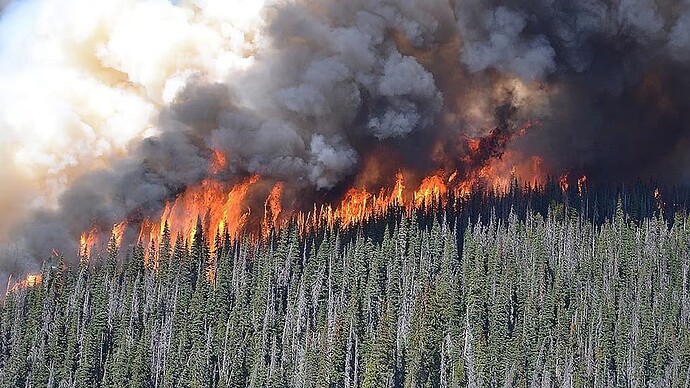Tom Fletcher grew up in the Peace River region and has covered B.C. politics and business as a journalist since 1984.
It’s been hot in southern Ontario, with smoke haze from forest fires — a relatively rare sight there compared to summers here in the west.
Cue the apocalyptic news coverage out of Toronto, where TV newscasts deploy weather maps that look like lava flows as the temperature reaches 30°C. “The world is burning,” announces the headline of a parenting advice column in The Globe and Mail. “Should we tell our children?”
The author’s children are not told about forest fires, but instead are gently advised that it’s important that the family drive an electric car, fly as little as possible, eat no meat and plant trees. They are not told about the huge, ongoing increase in greenhouse gas emissions in Asia, cancelling out many times over the modest reductions achieved at great cost in North America and Europe.
They are definitely not told about factors other than human carbon dioxide emissions that relate to the size and frequency of forest fires. Those factors are almost certainly more important, but you have to search in order to find them.
It’s just as well that the parenting columnist didn’t speak to her children about forest fires, since she describes the classic urban misconceptions. She notes that early statistics show Canada may be on its way to its second-biggest forest fire season, behind the huge summer of 2023.
Yes, Canada did set a modern record for area burned two years ago. It was the same year that the U.S. had one of its lowest forest fire years on record. If the incremental increase in atmospheric carbon dioxide is the primary cause, how can it affect one country but not the one next to it?
The answer, as with changes in the average temperature around the world, is that natural variability is larger than the trend line produced by statistics. It’s true that Canada has seen more communities damaged or destroyed by fire, but that’s largely because there are more communities. It’s true that we’ve seen bigger, more intense fires, but that’s mainly a function of decades of forest fire suppression that allowed fuels to build up far beyond the natural cycle of fire.
A key study on this was completed in 2017 by the University of British Columbia forestry faculty. It examined fire scarring on ancient trees in the Cariboo region, some dating back to the early 1600s. The survey found that between 1619 and 1943, there were 22 forest fires that scarred the bark of surviving trees. That’s one natural fire on average every 15 years, thinning smaller trees and leaving the bigger ones. After 1943, they stopped.
The Second World War was nearing its end, but the war on forest fires was just beginning, with the deployment of heavy equipment as well as aircraft. Saving timber was the goal, and the unintended consequences have piled up ever since.
More frequent fires not only thin a forest, they remove what foresters call “ladder fuels” that allow a ground fire to reach the treetops.
Last week the B.C. Forest Practices Board issued a little-noticed report that touches once again on the need for effective fuel management around communities. It calls for municipalities to be included in the interface area of logging projects, fixing a legal problem caused by different jurisdictions, and for logging to be used more effectively to prevent interface fires.
It’s the latest of a long series of studies and recommendations since the Okanagan fires of 2003 destroyed hundreds of homes. Huge fires can burn for months in unpopulated areas, but it’s only when homes start burning down that the public, media and politicians pay attention.
The terrible fire that swept through Jasper last summer was sparked by lightning, and destroyed a third of the town. A study of fire scars on ancient trees determined that large forest fires swept through the area every 40 to 60 years until Jasper was protected by the federal government in 1907. Then they stopped, suppressed to save the timber.
Similar debates flare up and fizzle out in the U.S. when fires destroy communities, as we saw after the latest fires around Los Angeles. This week the U.S. secretary of agriculture announced he is rescinding the 2001 “roadless rule” that covers 30% of the country’s national forests. This allows road construction and timber harvest on 59 million acres for forest management.
This approach is far more likely to reduce catastrophic fire than raising your kids to be vegan.
